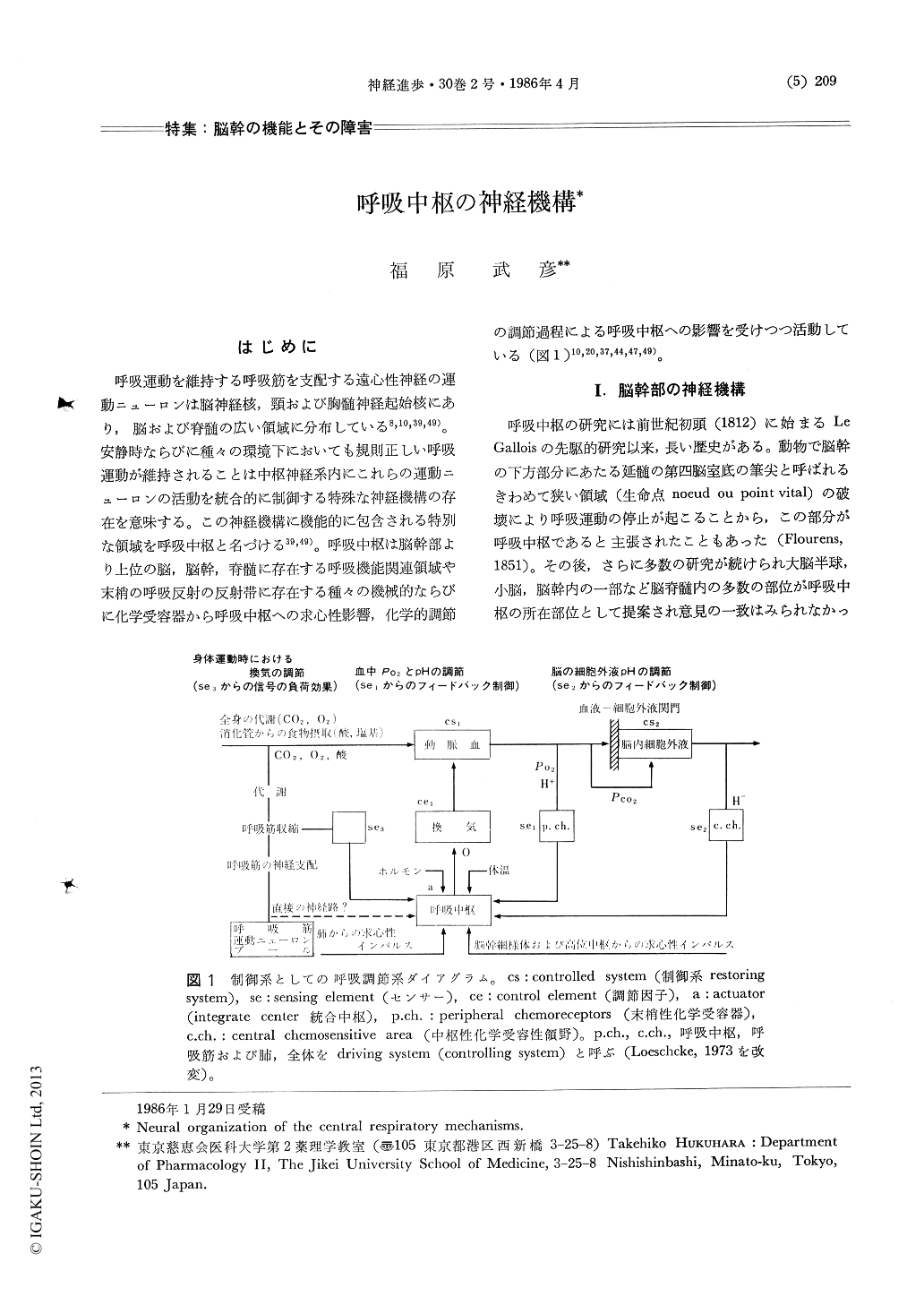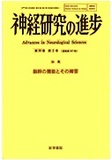Japanese
English
- 有料閲覧
- Abstract 文献概要
- 1ページ目 Look Inside
はじめに
呼吸運動を維持する呼吸筋を支配する遠心性神経の運動ニューロンは脳神経核,頸および胸髄神経起始核にあり,脳および脊髄の広い領域に分布している8,10,39,49)。安静時ならびに種々の環境下においても規則正しい呼吸運動が維持されることは中枢神経系内にこれらの運動ニューロンの活動を統合的に制御する特殊な神経機構の存在を意味する。この神経機構に機能的に包含される特別な領域を呼吸中枢と名づける39,49)。呼吸中枢は脳幹部より上位の脳,脳幹,脊髄に存在する呼吸機能関連領域や末梢の呼吸反射の反射帯に存在する種々の機械的ならびに化学受容器から呼吸中枢への求心性影響,化学的調節の調節過程による呼吸中枢への影響を受けつつ活動している(図1)10,20,37,44,47,49)。
The present views as well as the essentials of experimental results on the anatomical localizat-ion, functional and neuronal organization of the central respiratory mechanisms, classically expres-sed as the respiratory centers in the brain stem were critically reviewed. The following essential problems were reviewed and discussed: 1) spatial distribution of respiratory neurons in the brain stem of the various species of experimental animals;2) critical reexamination and reconsideration of the new and precise as well as conventional iden-tification procedures for unit activity of respiratory neurons by means of a new quantitative evaluat-ion for the periodicity of respiratory unitary dis-charges on the basis of correlation analysis; 3) spontaneous rhythmic discharge pattern of bulbar respiratory neurons before and after isolation ofthe medulla in situ by transection of the neuroaxis at the pontobulbar and bulbospinal junctions in the cat; 4) spontaneous unitary discharge pattern of a pontine and a bulbar respiratory neuron with simultaneous recording of both unit activities before and after brain stem transection at the pontobulbar junction; 5) reexamination of the physiological meaning of apneusis, apneustic bre-athing and gasping pattern of breathing; 6) alte-rations of the respiratory periodic burst activity of the cortical EEG (electroencephalogram) and effects of brain stem transection at the midpon-tine level there on; 7) spontaneous discharge pattern of the phrenic, hypoglossal and facial nerve activity and effects of brain stem transection at the pontobulbar and bulbospinal junction there on; 8) spontaneous rhythmic discharge of the phrenic nerve after ablation of the ventrolateral region of the nucleus tractus solitarii; 9) difference in stability of spontaneous burst activity of res-piratory neurons in the brain stem of the cat and rabbit; 10) differential sensitivity of pontine and bulbar respiratory neurons to barbiturates; 11) the possible location of the respiratory rhythm gene-rating mechanisms in the bulbar structures; 12) the possibility of the physiological and neuronal mechanisms for the generation of the respiratory rhythms.
It has been shown that the neural mechanism generating the respiratory rhythms exists in the brain stem involving pontine and medullary str-uctures. Periodic activity similar to eupnoea ori-ginating in the medullary neural mechanisms is dominant with respect to spontaneity over other rhythmic activities which have been described in other neural mechanism in the brain stem and the spinal cord. The evidences demonstrated by the recent experiments indicate that the dorsal respiratory and ventral respiratory group (DRG and VRG) of bulbar respiratory neurons proved to be the premotor organization in nature. Not only in the paralyzed but also in the anesthetizedcondition in cats and rabbits a variability of spontaneous discharge of respiratory neurons to a greater or lesser degree was observed. In the present experiments it has been shown that the stably discharging inspiratory and expiratory neu-rons having a smaller coefficient of variation for the volley period and a large correlation coefficient of autocorrelation were found in the lateral region of the bulbar reticular formation, but not in cor-responding areas in the medulla described as the high density regions in cats and in pontine struc-tures. This fact is not contradictory to and in accordance with the results of previous author's experiments obtained by brain stem transection techniques in combination with correlation analy-sis. Thus, the author suggest that the respiratory neurons, inspiratory and expiratory, which are discharging stably with a large correlation coeffi-cient of autocorrelation and a small coefficient of variation for the volley period, and are found in the bulbar reticular formation, are playing an essential role as the primary respiratory neurons in generating the respiratory rhythm in the bulbar mechanism.

Copyright © 1986, Igaku-Shoin Ltd. All rights reserved.


